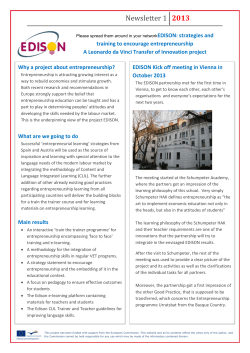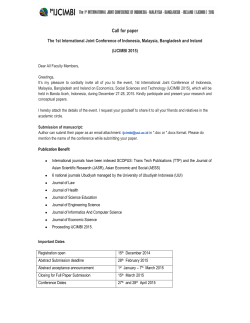
ENTREPRENEURSHIP AND OPEN INNOVATION
Call for Papers for a Special Issue ENTREPRENEURSHIP AND OPEN INNOVATION Submission Period: March 16, 2015 – May 15, 2015 Guest Editors Satish Nambisan, University of Wisconsin–Milwaukee Donald Siegel, University at Albany–SUNY Martin Kenney, University of California–Davis Background and Special Issue Purpose In recent years, many organizations have experimented with more open and collaborative innovation models and processes recognizing the value of external innovation networks and ecosystems (Chesbrough, 2003, 2006; Nambisan & Sawhney, 2007a). Such open and network-centric innovation has included collaborating with numerous partners in developing new products and services, establishing more open technology and innovation platforms, sourcing innovation and technologies from diverse types of external sources for internal development, and participating in and contributing to ‘open source’ projects in different industries. In some cases, this has involved creating markets in intellectual property, which was owned by firms, but not exploited by them (Arora and Fosfuri, 2003). Similar open innovation approaches have also been adopted by nonprofits, government agencies, and other organizations in the public/social sector (Nambisan, 2009; Clay & Paul, 2012). The wider recognition and adoption of open innovation (henceforth, OI) approaches across various sectors and industries has yielded promising new entrepreneurial opportunities for diffusing knowledge and inventions (by independent inventors, university researchers, labs and research centers, customers/users, citizens, etc.). This special issue will focus on how such OI approaches—in all their diversity—affect the nature, structure, process, and outcomes of entrepreneurship. In particular, we invite scholars to focus on the implications of OI for corporate, university, and social entrepreneurship. Open innovation as a concept has encouraged experimentation with new organizational arrangements and reconsideration of which types of entrepreneurship are most effective. The reasons for this include: 1) Startups or new ventures have proven to be a costly and inappropriate way to commercialize many innovations due to the invention’s narrow scope of application, low profit potential, or lack of an appropriate business model for monetization. At the same time, the opening up of corporate innovation pipelines to ideas and technologies from outside and the associated introduction of new types of innovation intermediaries (e.g., Nambisan and Sawhney, 2007b) have made it possible for companies to entertain a wider range of external ideas and technologies and to engage in new forms and models of corporate entrepreneurship (e.g., Anthony, 2012). Note that our definition of corporate entrepreneurship includes both organizations and employees as entrepreneurs. 2) Many promising university-based technologies fail to reach the market place, due to the lack of appropriate internal and external innovation structures to facilitate their transfer and commercialization (Grimaldi et al., 2011). The adoption of OI practices and the recent emergence of new types of external innovation infrastructure could potentially alleviate this (Nambisan et al., 2012). At the same time, many companies claim that universities have become too rigid in forging collaborations and too aggressive in asserting their intellectual property rights (Siegel et al., 2003), what David Mowery (2001) refers to as the rise of the “patent” university. These concerns are heightened because, as Kenney and Mowery (2014) show, much university knowledge is transferred and entrepreneurship encouraged through complex bi-directional flows of knowledge. Thus, OI approaches question such rigid IP-related practices and indicate the critical need to re-examine the overall nature of university-industry partnerships in innovation commercialization. 3) OI approaches are being adopted in the public and non-profit sectors, as a result of advancements in information technology, government austerity, and the complex nature of civic problems, thereby motivating new forms of social innovation and social entrepreneurship. One of the outcomes of OI has been the involvement of organizations in all three sectors—public, private, and nonprofit—in promoting and facilitating social entrepreneurship initiatives, particularly in emerging economies. It is also evident that to successfully engage with citizens and other actors in social entrepreneurship, organizations will need to adopt structures, strategies, and practices that are more open and collaborative (Battilana and Dorado, 2010). Despite these important trends, our understanding of the impact of the different OI models and practices on entrepreneurship is limited. The objective of this special issue is to provide a forum for scholars to report on research on emerging models of OI and strategy, as applied to corporate entrepreneurship, university entrepreneurship, and social entrepreneurship. We welcome research that: (a) applies existing/emergent theoretical perspectives from economics, sociology, psychology, and other disciplines to improve our understanding of how the emergence of more open innovation ecosystems and models may reshape entrepreneurship and entrepreneurial activities; (b) develops new conceptual models integrating concepts from entrepreneurship and innovation management to develop a fine-grained understanding of the diverse new actors and their roles in entrepreneurship due to the adoption of OI approaches; and, (c) assesses the impact of the changes in the structure and process of entrepreneurship driven by OI on technology commercialization. Possible Research Questions Some possible research questions are listed below. This is by no means an exhaustive list. For research questions not listed below, scholars should also consider the extent to which their questions fit with SEJ’s core themes (http://sej.strategicmanagement.net/themes.php). Change: How does the increasing adoption of OI affect the nature and the outcomes of entrepreneurship? How have entrepreneurship practices evolved to address the opportunities and challenges offered by OI? What are the implications of OI for the roles, responsibilities, and structures of university technology transfer offices? How should companies organize themselves to promote and pursue corporate entrepreneurship initiatives in a more open and collaborative innovation setting? Innovation: How does the process of entrepreneurship unfold as new types of innovation intermediaries (and other such external entities) partner with companies, universities, and nonprofits? What is the impact of new types of innovation intermediaries on the nature and process of corporate entrepreneurship? What are the different forms of complementarity between university entrepreneurship processes and corporate entrepreneurship processes? Entrepreneurial Actions, Innovation, and Appropriability: To what extent are different IP rights management approaches relevant to (or have been embraced by) universities, research centers, nonprofits, and other agencies? What are some of the associated institutional barriers to adopting more open approaches? How should organizations evaluate the options to pursue ‘open source’ or license-based approaches to the diffusion of knowledge and inventions in various contexts? How do entrepreneurs manage the balance between open source strategies and traditional closed IP strategies such as patenting and trade secrecy? Behavioral Characteristics of Entrepreneurial Activity: How do OI approaches transform the roles of ‘scientistentrepreneur’, ‘corporate entrepreneur’, and ‘user/citizen entrepreneur’? What are the cognitive capabilities, processes, and skills that assume importance as individuals (scientists, corporate employee, user, citizen, etc.) pursue entrepreneurial opportunities that arise from OI? Creativity, Imagination, and Opportunities: How are innovation opportunities “discovered” by organizations in the context of (a) corporate entrepreneurship; (b) university entrepreneurship; and (c) social entrepreneurship? What are the mechanisms used by universities to enhance companies’ visibility into their new technologies and other research output? What is the role and impact of new innovation intermediaries in such opportunity discovery and recognition? Entrepreneurship and Economic Growth: How do OI approaches affect the relationship between entrepreneurship and regional economic development and social well-being? How does OI affect property-based institutions involved in entrepreneurship and technology-based regional economic development, such as incubators/accelerators and science/technology parks? Deadlines, Submission and Review Process Submissions to this special issue should be prepared in accordance with SEJ’s submission process described at http://sej.strategicmanagement.net. The submission window is from March 16, 2015, to May 15, 2015. Please make sure to indicate that your submission is for the special issue on Entrepreneurship and Open Innovation. Publication of this special issue is planned for March 2018. Further Information For questions regarding the content of this special issue, please contact the guest editors: Satish Nambisan, University of Wisconsin–Milwaukee, nambisan@uwm.edu Donald Siegel, University at Albany–SUNY, dsiegel@albany.edu Martin Kenney, University of California–Davis, mfkenney@ucdavis.edu For questions about submitting to the special issue contact the SEJ managing editor: Sara DiBari, sejeditorial@wiley.com. References Anthony, S. 2012. The New Corporate Garage. Harvard Business Review, September 2012. Arora, A. and A. Fosfuri. 2003. “Licensing the Market for Technology," Journal of Economic Behavior & Organization, 52(2): 277–295. Battilana, J. and S. Dorado. 2010. "Building Sustainable Hybrid Organizations: The Case of Commercial Microfinance Organizations," Academy of Management Journal, 53(6), 1419–1440. Chesbrough, H.W. 2003. Open Innovation: The New Imperative for Creating and Profiting from Technology. Boston, MA: Harvard Business School Press. Chesbrough, H. 2006. Open Business Models: How to Thrive in the New Innovation Landscape. Harvard Business School Press, Boston, MA. Clay, A. and R. Paul. 2012. Open Innovation: A Muse for Scaling, Stanford Social Innovation Review, Fall 2012, 17–18. Grimaldi, R., M. Kenney, D.S. Siegel, and M. Wright. 2011. 30 Years after Bayh-Dole: Reassessing Academic Entrepreneurship. Research Policy, 40(8): 1045–1057. Kenney, M. and D. Mowery. 2014. Public Universities and Regional Development: Insights from the University of California System. Palo Alto, CA, Stanford University Press. Mowery, D., 2001. The Changing Role of Universities in the 21st Century U.S. R&D System. AAAS Science and Technology Policy Yearbook, 253–271. Nambisan, S. 2009. Platforms for Collaboration, Stanford Social Innovation Review, Summer, 44–49. Nambisan, S. and M. Sawhney. 2007a. The Global Brain: Your Roadmap for Innovating Faster and Smarter in a Networked World. Wharton School Publishing, PA. Nambisan, S. and M. Sawhney. 2007b. A Buyer’s Guide to the Innovation Bazaar. Harvard Business Review, June 2007, 109–118. Nambisan, S., Bacon, J. & J. Throckmorton. 2012. The Role of the Innovation Capitalist in Open Innovation: A Case Study & Key Lessons Learned. Research-Technology Management, May–June 2012, 49–57. Siegel, D. S., Waldman, D., and Link, A.N. 2003. Assessing the Impact of Organizational Practices on the Relative Productivity of University Technology Transfer Offices: An Exploratory Study. Research Policy, 32(1): 27– 48. The SEJ is published by Wiley-Blackwell and is one of the many activities of the Strategic Management Society (SMS). The Society is unique in bringing together the worlds of reflective practice and thoughtful scholarship. The Society consists of nearly 3,000 members representing over 60 different countries. Membership, composed of academics, business practitioners, and consultants, focuses its attention on the development and dissemination of insights on the strategic management process, as well as fostering contacts and interchange around the world. SMS Executive Office Rice Building – Suite 215 815 W Van Buren Street Chicago, IL 60607 • USA +1 312-492-6224 sms@strategicmanagement.net
© Copyright 2025









